This post may contain affiliate links. Please read our disclosure policy.
THIS IS IT GUYS! The vegan cheese you have been looking for. Sharp, and creamy with a white and flowery rind, this vegan camembert is simply mind blowing! Made using traditional cheese-making techniques and just 5 ingredients!
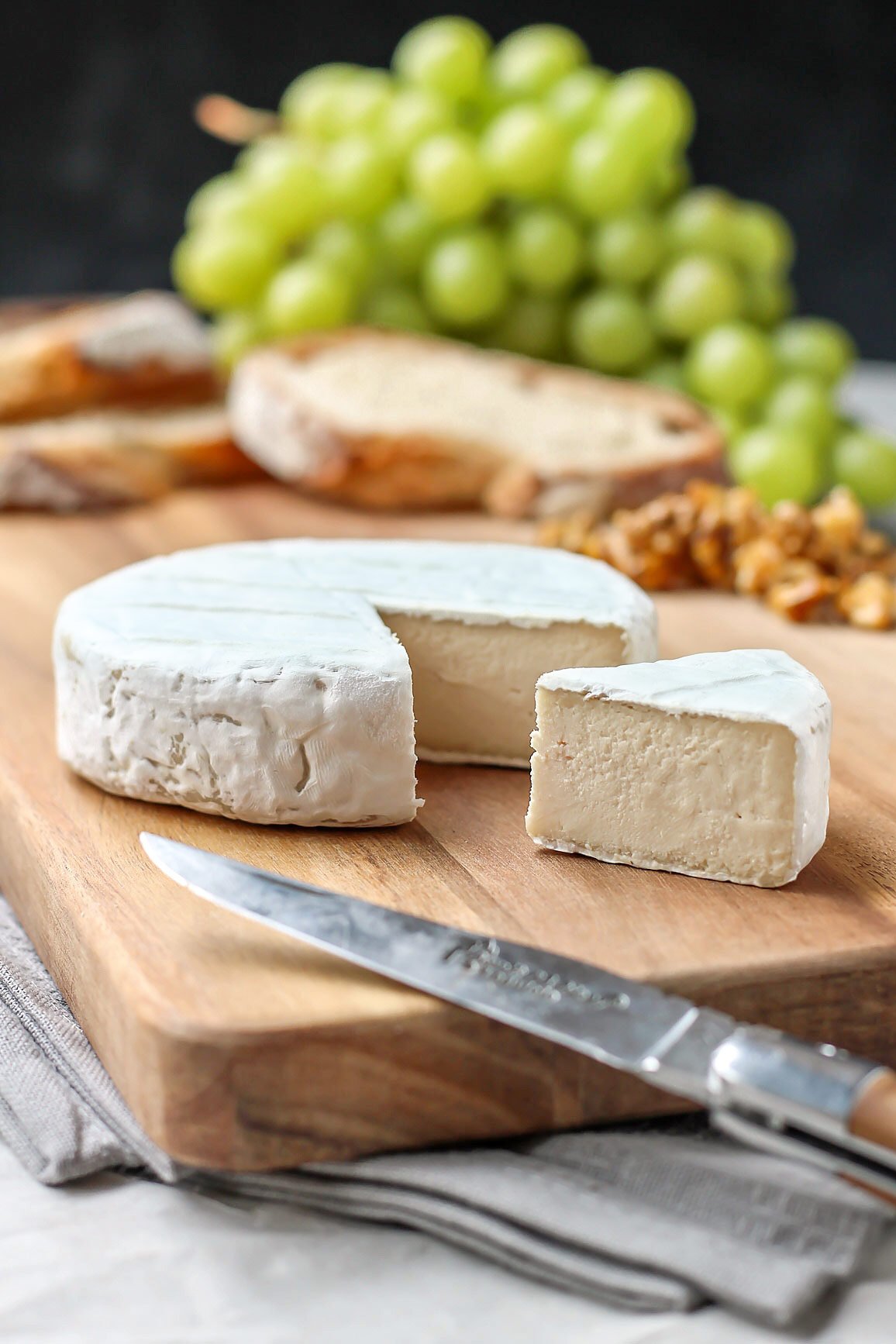
After months of research and testing, I finally found how to make a nut cheese with the taste and texture of a real camembert. Living in France, I ate quite a lot of artisanal cheese before going vegan, and I can tell you this one seriously taste like a real one.
⭐️ Why You Should Try This Recipe
- The flavor and texture are incredible. Creamy on the inside, slightly chewy on the outside, and perfectly tangy, I can confidently say this vegan camembert tastes SO much better than most other vegan cheese recipes.
- Made using traditional techniques. While cashew cream replaces dairy milk here, we are using traditional cheese-making methods to age this cheese, giving it a true cheese aroma. There is no nutritional yeast or flavorings used here. It all comes from the cultures and the aging process.
- The reviews speak for themselves. With over 250 ★★★★★ ratings, it’s no question readers love this camembert!
- It’s healthy. This vegan camembert is packed with healthy fats and probiotics that can help improve gut health.
📘 What is Camembert
Camembert is a soft and creamy cheese that first appeared in Normandy, France, around 1554. It is inoculated with a mold called “Penicillium Candidum”, responsible for producing a bloomy rind, and is usually aged for 2-3 weeks.
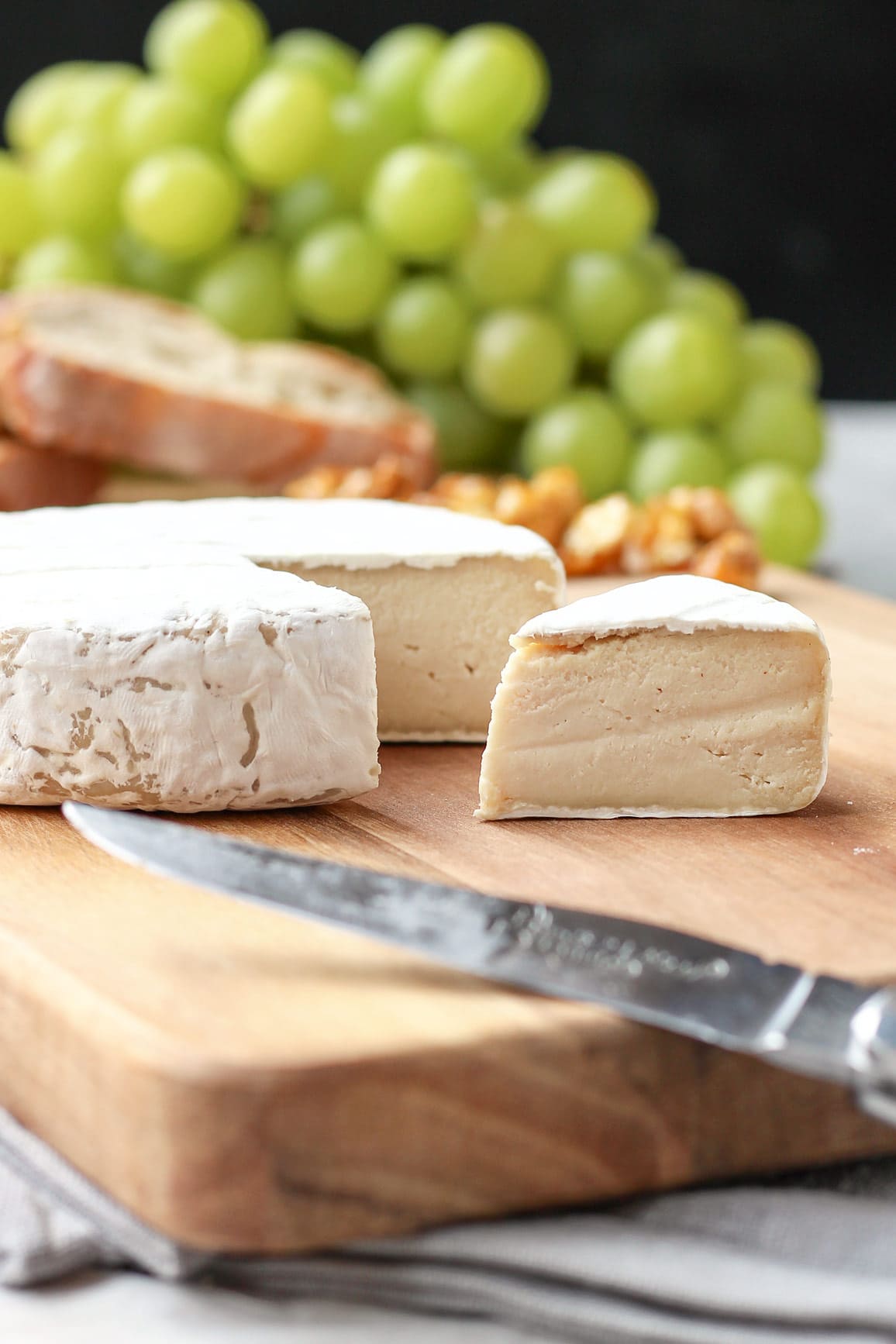
🥛 Ingredient Notes
This cheese contains only FIVE ingredients: raw cashews, cultures, water, salt, and the secret ingredient for the rind: Penicillium Candidum. Here are some notes about each ingredient:
- Cashews – Cashews make the base of this cheese. You want to use raw cashews, not roasted ones.
- Probiotics – These will give the cheese its tanginess. You can use acidophilus or mesophilic culture. Check out the Tips to read more about it.
- Penicillium Candidum – Penicillium Candidum is a mold that grows on camembert/brie and gives it a white and soft rind. It also adds a lot to the taste by giving a mushroomy flavor. It’s an essential ingredient to this recipe and cannot be omitted or substituted.
- Water – To blend the cashews and turn them into a cream. I recommend using filtered water or water that has been boiled and cooled down.
- Salt – For flavor and to prevent bad bacteria from growing.
🥣 How To Make Vegan Camembert
Before starting: Be aware this is not a quick recipe, don’t expect to have vegan camembert ready tonight. The whole process will take you about three weeks. BUT: It is totally worth it!
1. Prepare the cashew cream
- Drain the soaked cashew and transfer them to a high-speed blender. You can use a food processor, but you won’t get the same silky smooth texture.
- Add the water and blend on high speed for 1-2 minutes or until it forms a thick and smooth cream.
- Sprinkle the acidophilus probiotic and the Penicillium Candidum and blend for another 5-10 seconds.
Note: There are two methods to innoculate the Penicillium Candidum. The first one consists of mixing it into the ingredients directly. The second one consists of spraying it on the outside of the cheeses after they have been shaped. I used the first method here, which gives the best result, in my opinion.
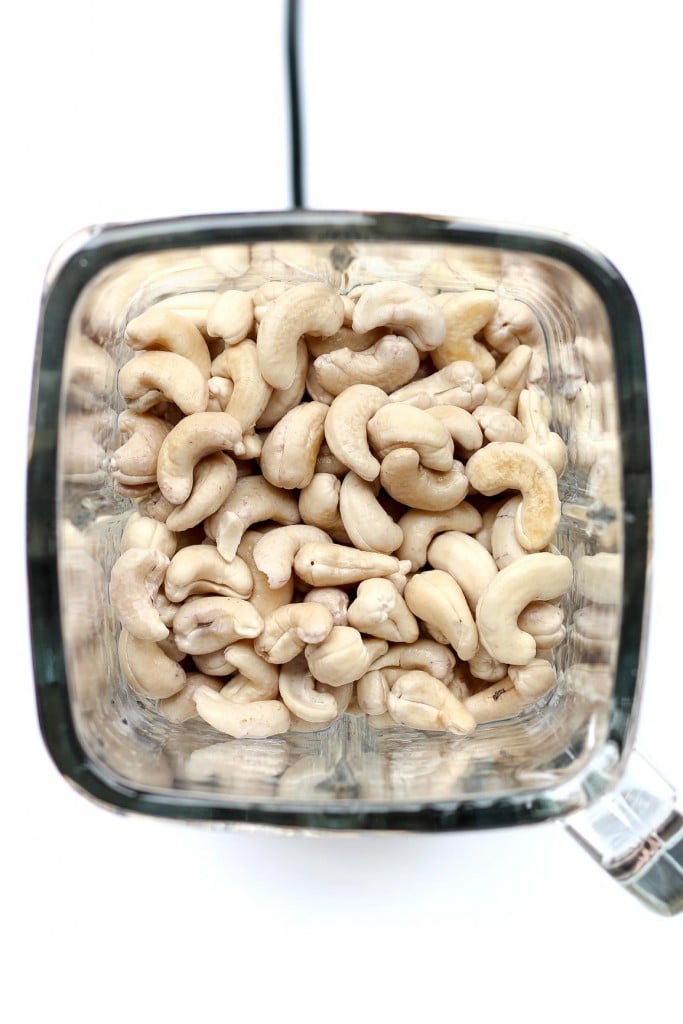
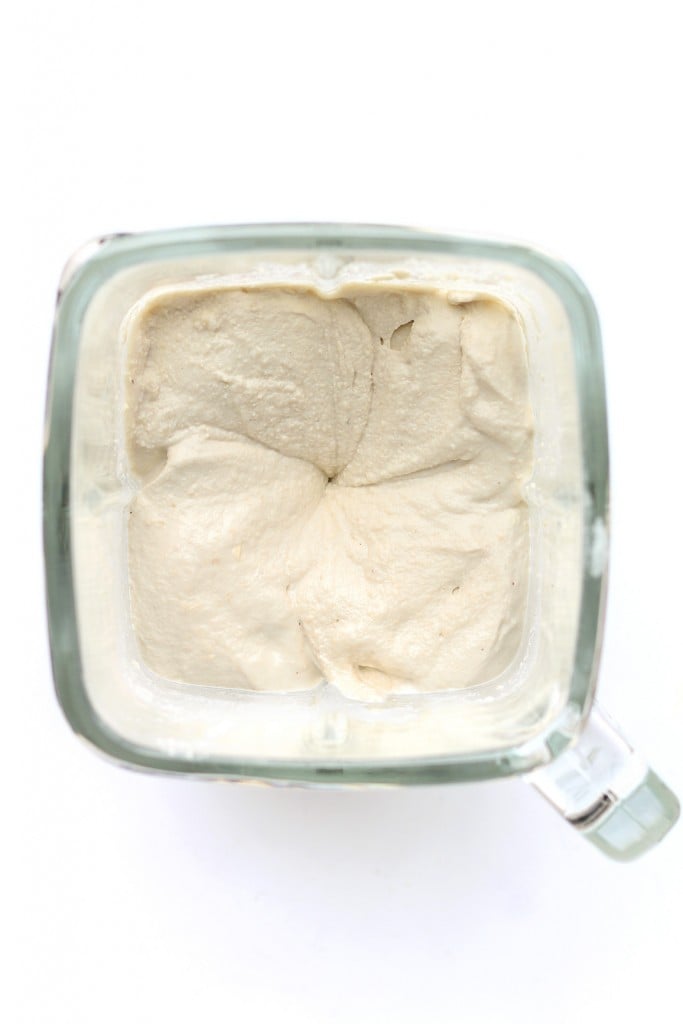
2. Let the cashew cream ferment
Once you have a very smooth and thick cashew cream:
- Transfer it to a clean bowl and cover it with plastic film to touch.
- At this point, let the cashew cream ferment at room temperature in a dark place for 24-48 hours.
- After that, the cashew cream should have small bubbles and a fluffy texture. This means the fermentation process worked. You can taste it. It should have a subtle tanginess.
- Transfer the fermented cashew cream to the refrigerator and chill for at least 4 hours or overnight. This step will allow it to firm up a little bit.
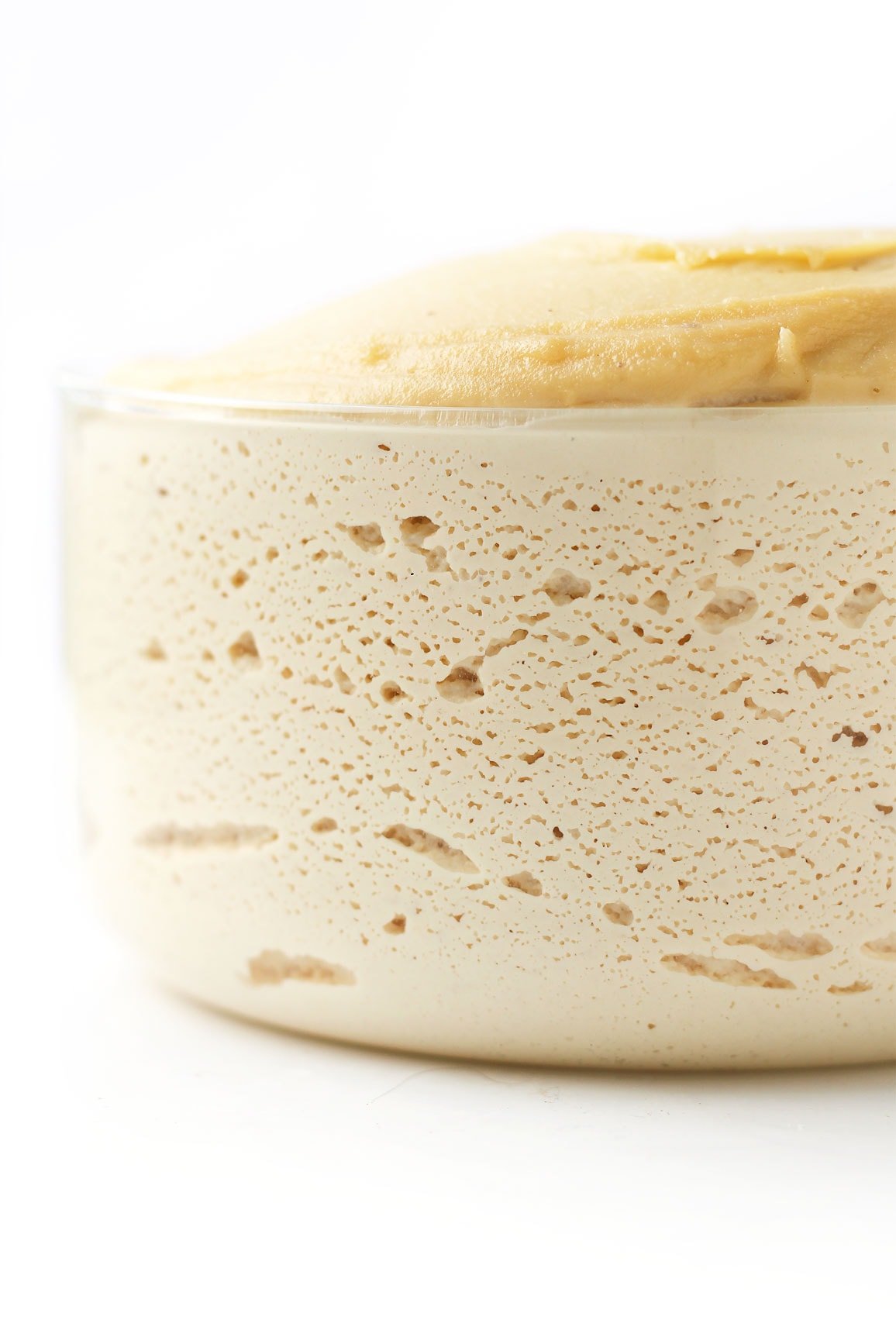
3. Shape and salt the cheeses
- Line 3 springform pans (I used these Wilton 4-inch springform pans) with parchment paper or plastic wrap, covering the bottom and sides. The goal is to prevent the cheese from touching and sticking to the metal.
- Fill each pan with the cashew cream mixture and press it down using plastic film, so it doesn’t stick to your hands. Cover with plastic film to touch.
- Refrigerate overnight.
- The next day, carefully remove the cheeses from the springform pans and place them in a container lined with parchment paper. Be careful, the cheeses will be very soft (like a thick cream).
- Sprinkle about 1/4 tsp of salt over the top of each cheese, and rub with your finger to evenly distribute the salt. Carefully flip the cheeses and sprinkle the bottoms and sides with more salt.
- Close the container and place it in your refrigerator (in the warmest area) or a room at a temperature of 52-56°F (11-13°C).
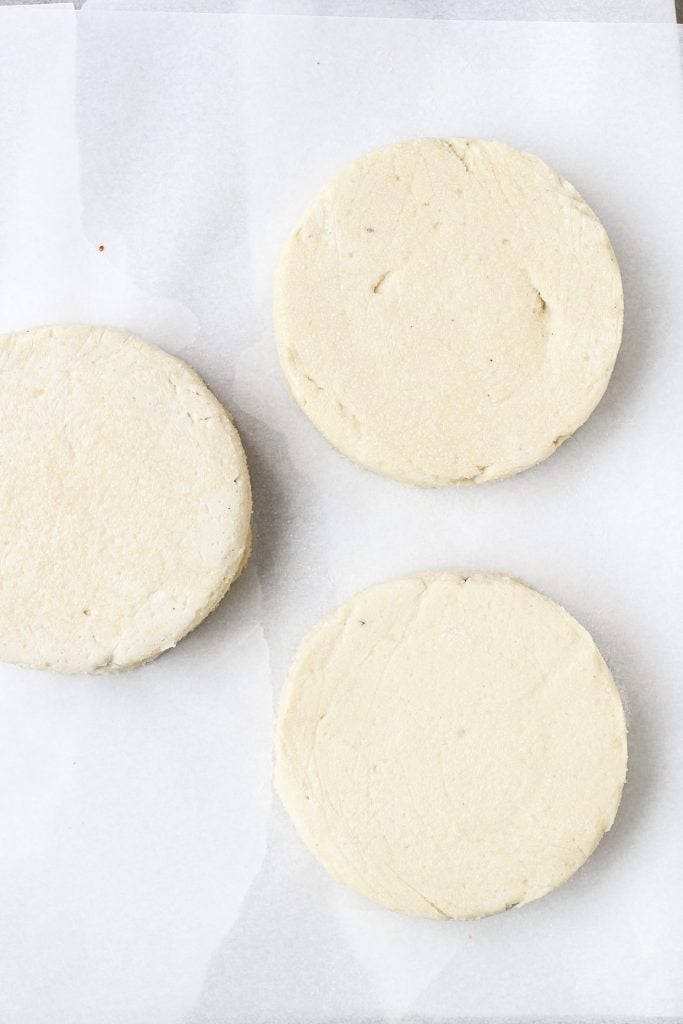
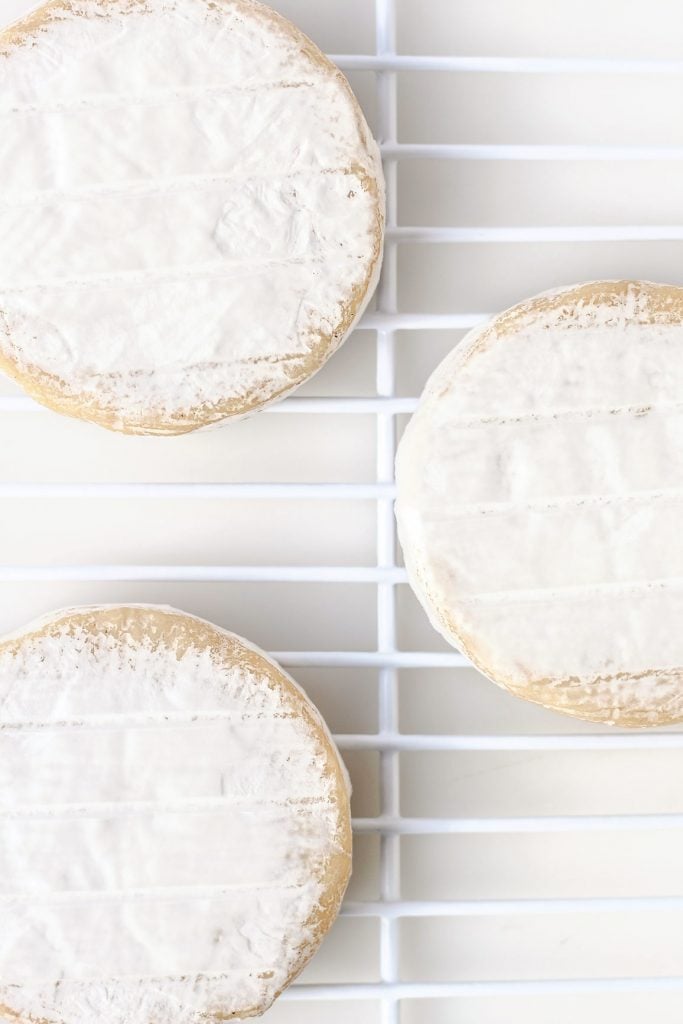
4. Age the cheeses
Finally, the most exciting step!
- Every day, carefully flip the cheeses. The cheeses will be very soft at the beginning, like cream cheese. Don’t worry; they will firm up after a few days. If you see water or condensation in the container, remove it using a kitchen paper towel.
- After 7-10 days, the cheeses should be slightly firmer. At this point, you can place them on a clean grid (that fits in your container). If you don’t have a grid, place the cheeses on chopsticks. This will allow airflow, and the mold will grow more uniformly.
- Continue flipping the cheeses every day for the next 7 days. The mold will start to appear in the following days if it hasn’t appeared already.
- After a total of 2 weeks, the cheeses should be fully covered with a white and fluffy rind. You are almost done!
- Wrap the cheeses in parchment or cheese paper and place them in the refrigerator for at least 2 days. The longer you let them age, the sharper they will become.
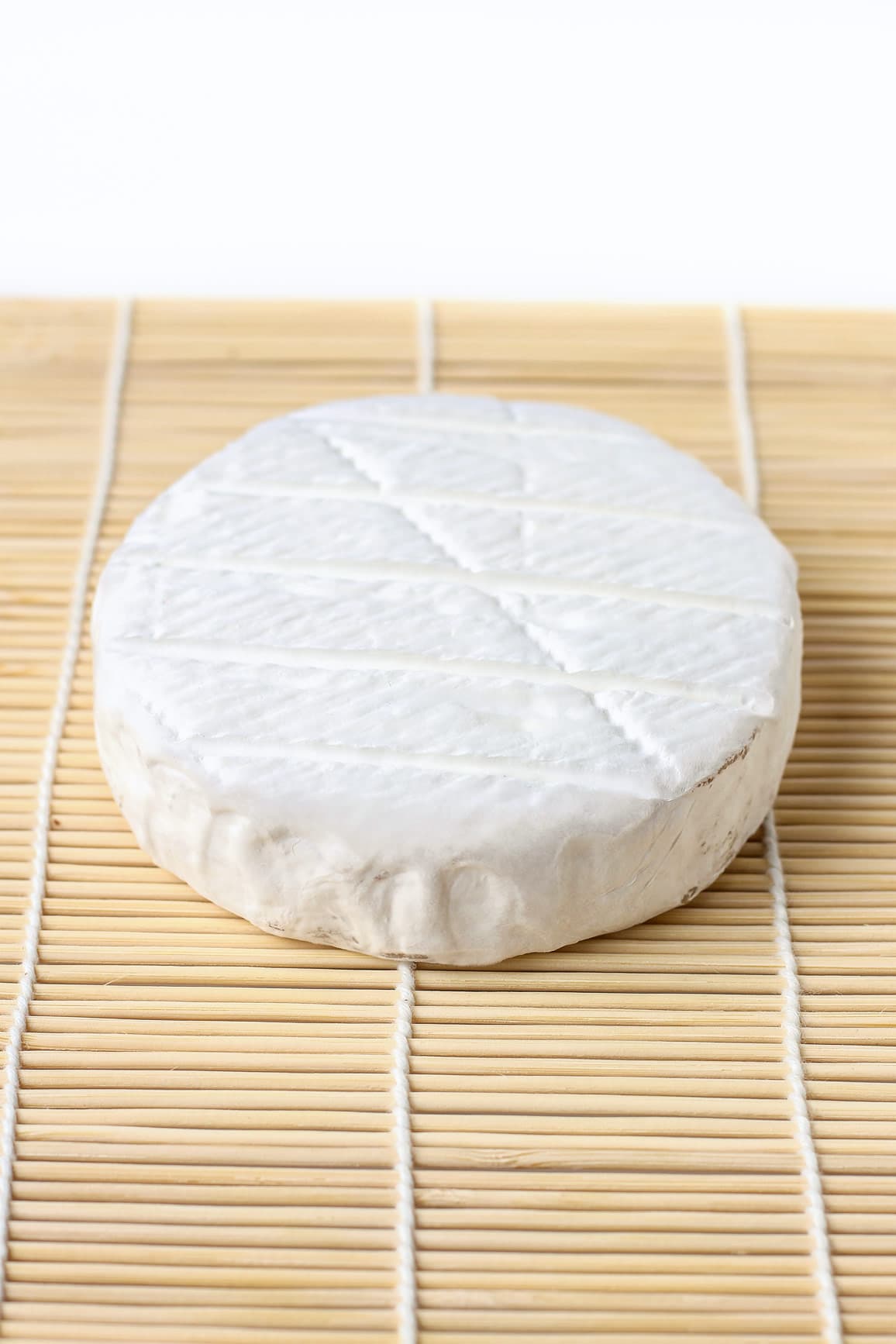
🥖 How To Serve It
Enjoy with french bread, Vietnamese baguette, fig chutney, caramelized walnuts, or even a drizzle of pure maple syrup if you like the combination of sweet and salty.
Regarding beverages, this camembert pairs well with cider, Champagne, Cabernet Sauvignon, apple liquor, beer, or a good apple juice if you don’t drink alcohol. The apple undertones of cider or apple juice contrast very well with the slight bitterness of the camembert!
❄️ Freezing
After aging the cheeses, wrap them in cheese paper or plastic film. You can keep them in the freezer for up to 3 months. Thaw overnight in the refrigerator.
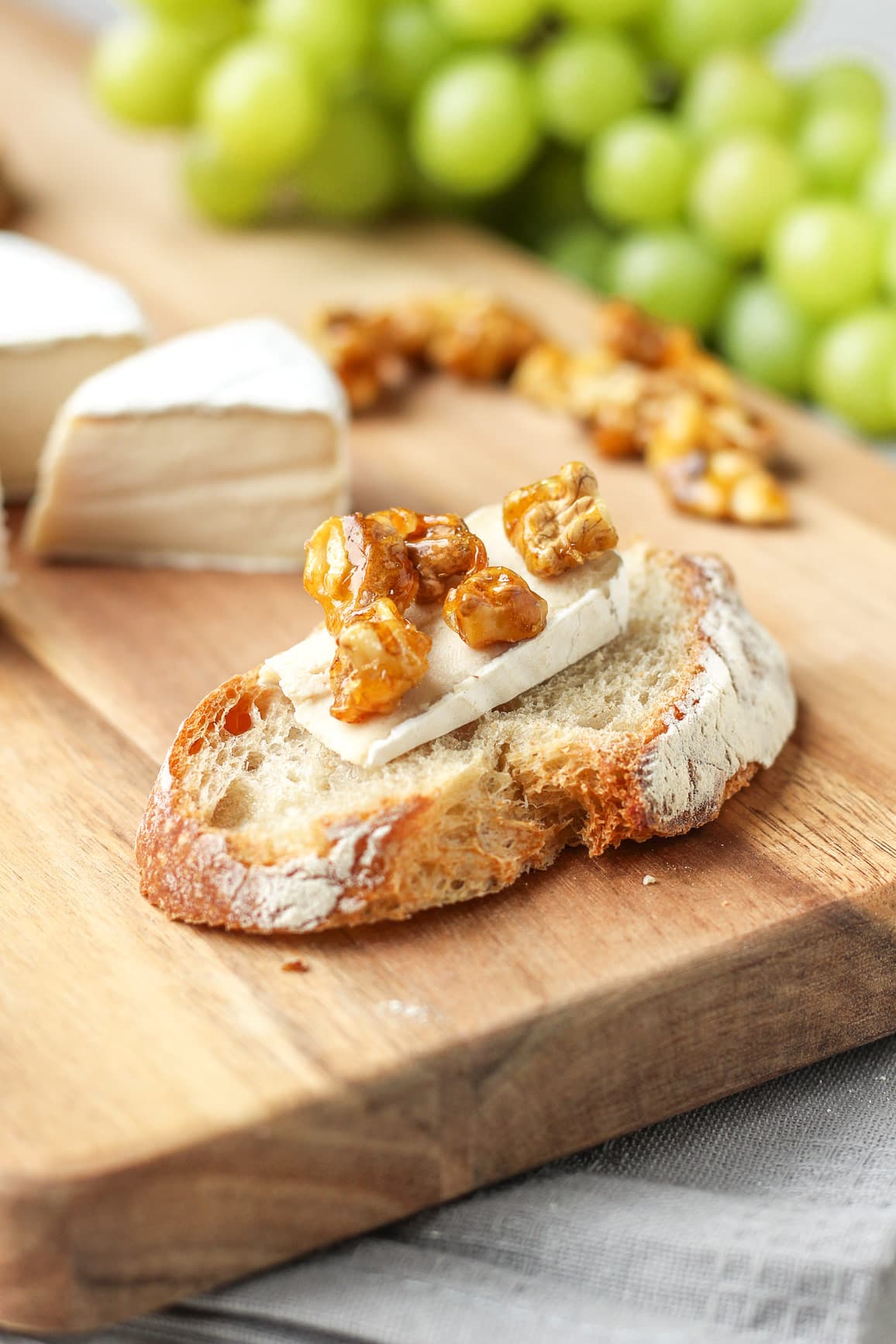
📔 Tips
- Do not omit or substitute any ingredient. This recipe is not versatile. If you want to succeed with it, do not change the ingredients or method.
- Use gloves. While not mandatory, I recommend using gloves while handling the cheeses. It will prevent bad bacteria from contaminating your cheeses.
- Regarding the Penicillium Candidum: The links provided here for Penicillium Candidum may not redirect to a fully vegan product. If you want to find a 100% vegan one, you will have to do your own research (it’s available in many cheese-making shops). Be aware that non-vegan ones are grown on lactose, meaning it contains *traces* of lactose. Considering the amount used, you could still consider your cheese 99,99% vegan. It’s up to you to choose which one fits your beliefs best.
- Regarding the Acidophilus: In this recipe, I used the Advanced Acidophilus Plus from Solgar, which contains 500M microorganisms per capsule. You can use a different brand, but you may have to use less if it contains more microorganisms. Alternatively, you can replace the acidophilus with 1/16 teaspoon of mesophilic, which is a culture made specifically for cheese making. It will yield a slightly less tangy and more buttery flavor.
- Depending on the temperature in your fridge/aging room, the mold might take more or less time to develop. The colder the temperature, the longer it will take to develop.
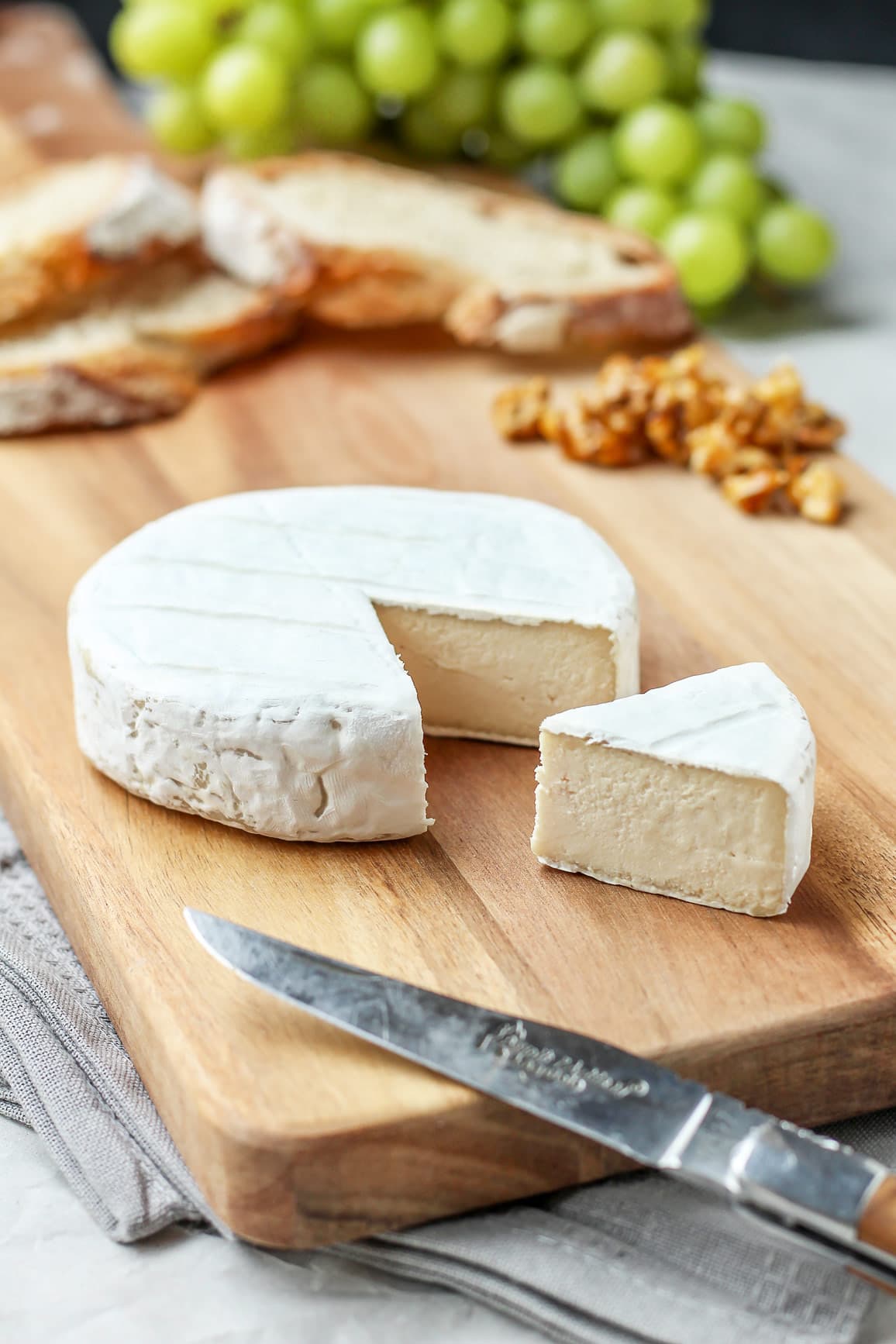
💬 FAQ
Yes! It is totally safe to eat the rind. That’s actually where most of the flavor lies!
Vegan camembert has a nice tanginess and earthiness with notes of mushrooms and butter.
You can find it online on cheese-making websites or ask your local cheese maker to sell you some.
While some readers had success using a mix of different nuts, I haven’t personally tried it yet. I recommend sticking to cashews for a creamy consistency.
No, Penicillium Candidum is essential to this recipe. It’s responsible for the flavor and texture.
After the aging process, vegan camembert will keep for up to one month in the refrigerator, wrapped in cheese paper. Once cut, it will keep for about 1 week.
No, this vegan camembert doesn’t melt but will soften when heated.
Both kinds of cheese originate from different areas of France. One comes from Normandy, while the other comes from “Île-de-France.” The other difference is that Brie is often larger than the camembert, weighing around 100 pounds instead of 9 ounces for the camembert. If you want, you can shape this vegan cheese into a large wheel instead of 3 small ones to make vegan brie!
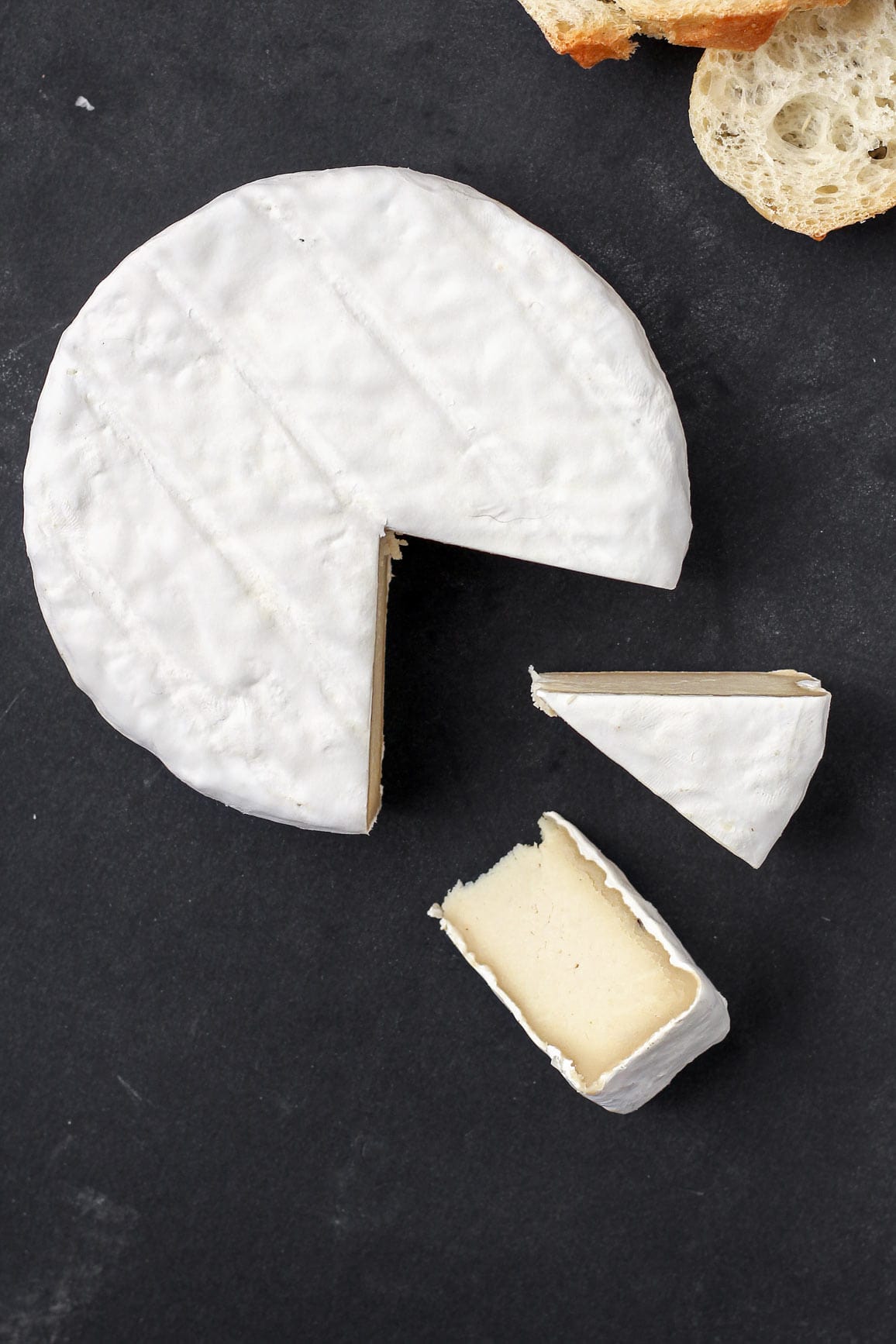
This vegan camembert will surely impress any cheese lover and even your non-vegan friends! It’s creamy, rich, and just delicious!
Disclaimer: Many people have been making this cheese without giving any credit and labeling it their own. I worked really hard to create this recipe and had to do a ton of experiments before releasing it. Please give credit by citing Full of Plants and linking to this website.
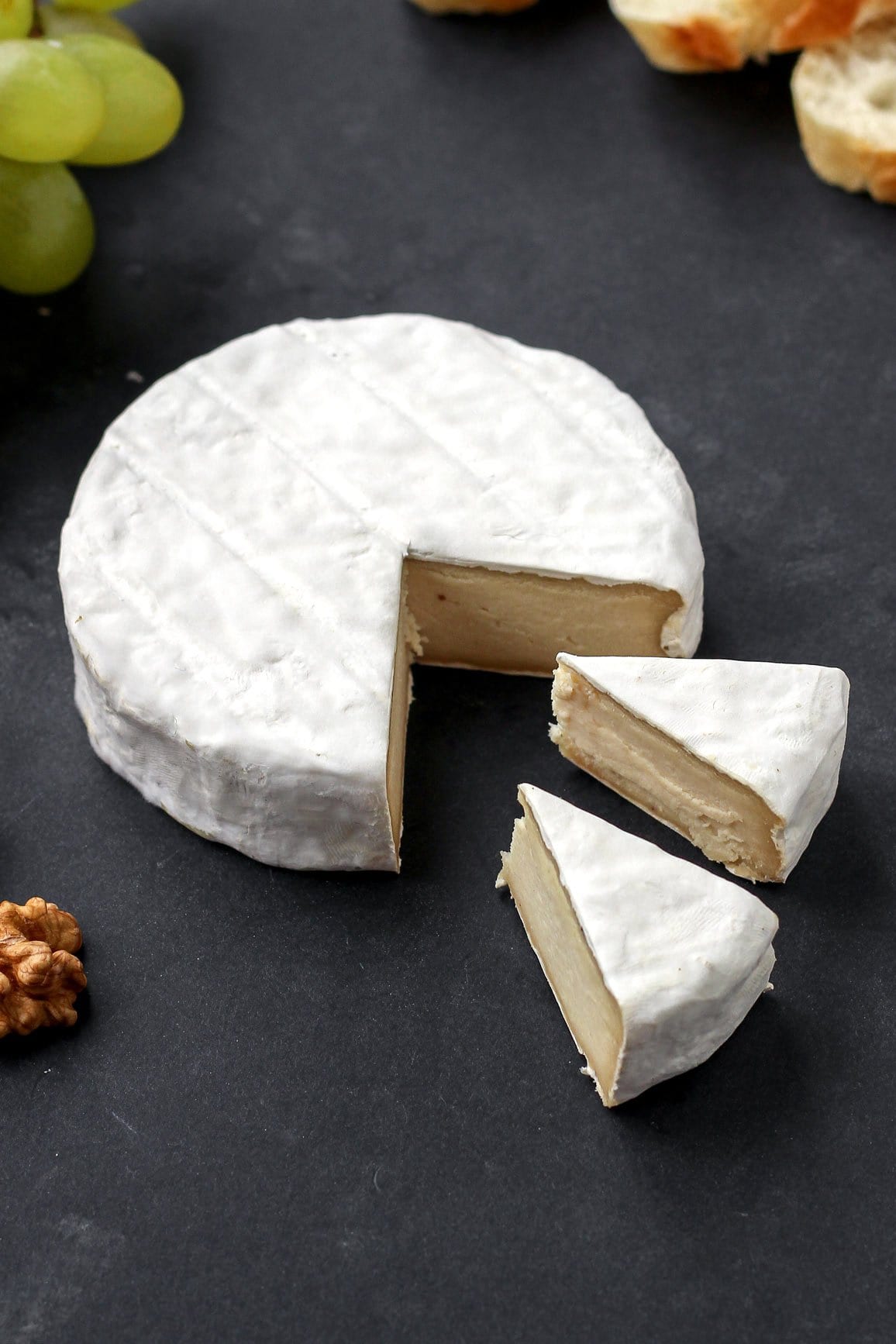
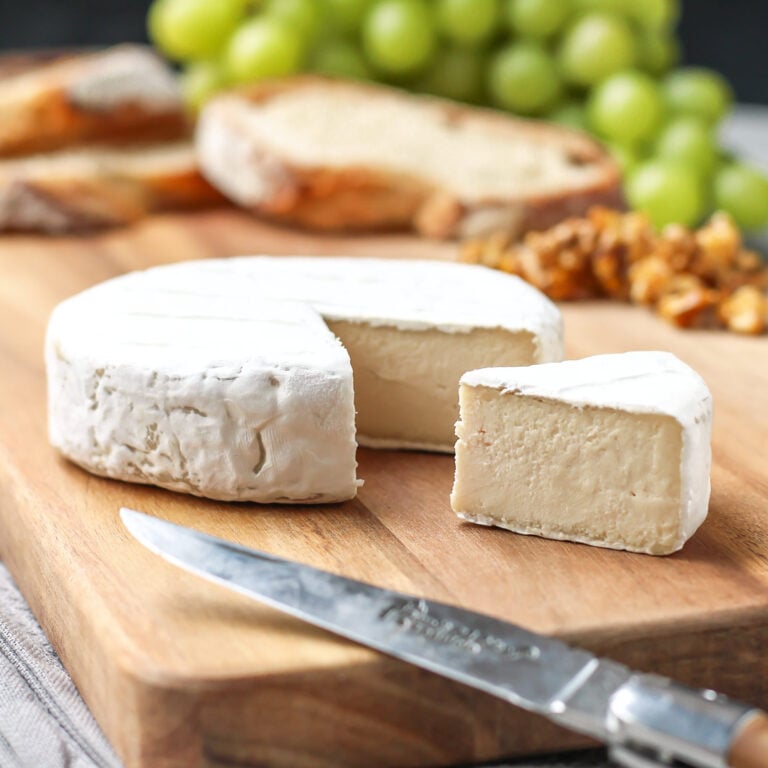
Vegan Aged Camembert Cheese
Ingredients
- 4 cups raw cashews soaked overnight
- 8-10 tbsp filtered water (or boiled water cooled down)
- 8 capsules Acidophilus probiotic or 1/8 tsp mesophilic
- 1/8 tsp Penicillium Candidum powder or liquid
- 2 tsp sea salt
Instructions
Prepare the cashew cream
- Drain the cashews and place them in a large glass bowl. Bring a large pot of water to a boil. Once boiling, pour the water directly onto the cashews. Let sit 1-2 minutes, and drain the cashews again. This step will help kill possible bacteria.
- Place the cashews in the bowl of a blender or food processor. Add 8 tablespoons of filtered water. Blend on high speed, scraping down the sides from time to time, until you get a very smooth cream. This step might take about 10 minutes, depending on your blender.
- Open the probiotic capsules and add the powder to the blender. Add the Penicillium Candidum, and blend on high speed for another 10-15 seconds.
- The cashew cream should be smooth but quite thick. If needed, add 1 tablespoon of water at a time until smooth. Do not add too much water or your mixture will be too liquid.
- Let it ferment: Transfer the cashew cream to a clean glass bowl, cover it with plastic film to touch, and let it sit at room temperature for 24-48 hours in a dark place. This step is important to let the cheese ferment and get a tangy flavor. Note: The cashew cream should have small bubbles and a fluffy texture. This means the fermentation process worked.
- Transfer the cashew cream to the refrigerator and chill for at least 4 hours (or overnight). The cashew cream will firm up a bit and become easier to work with.
Shape the cheeses
- Line 3 4-inch springform pans with parchment paper. You want to cover the bottom and sides. Alternatively, you can also use plastic film if you prefer. The goal is to prevent the cheese from touching the metal. Fill each pan with the cashew cream and press it down using plastic film, so it doesn't stick to your hands. Refrigerate overnight.
- The next day, carefully remove the cheeses from their springform pans and place them in a container lined with parchment paper.
- Sprinkle about 1/4 tsp of salt over the top of the cheeses. Next, using a plate lined with parchment paper, very carefully flip the cheeses. Sprinkle the tops and sides with more salt. The cheeses will still be very soft, like cream cheese. Don't worry, they will be easier to work with after 3-4 days, as salt will remove some moisture.
Aging
- Close the container and place it in your refrigerator (in the warmest area) or a room at a temperature of 52-56°F (11-13°C). Important note: You will age the cheeses at this temperature for the next two weeks. Do not store them at a temperature higher than 56°F (13°C). Also, the cheeses must stay in the closed container during the whole process, it will prevent them from drying.
- Every day, carefully flip the cheeses. Always use clean hands or work with gloves (or plastic film) to make sure you are not touching the cheeses. If you see water or condensation in the container, remove it using a kitchen paper towel.
- After 7 days, the cheeses will be a little bit firmer, and you should be able to place them on a plastic grid or chopsticks (that fits inside your container). This will allow airflow, and the mold will grow more uniformly.
- Continue flipping the cheeses every day for the next 7 days. The mold will start to appear in the following days, if it hasn't appeared already.
- After a total of 2 weeks, the cheeses should be completely covered with a white and fluffy mold. At this point, wrap the cheeses in parchment or cheese paper and place them in the refrigerator for at least 2 days. The longer you let them age in the refrigerator, the sharper they will become.
- Enjoy this vegan camembert with french bread, fresh figs, and/or nuts!
- Vegan camembert will keep for up to 1 month in the refrigerator.
Video
Notes
- Do not omit or substitute any ingredient. This recipe is not versatile. If you want to succeed with it, do not change the ingredients or method.
- Use gloves. While not mandatory, I recommend using gloves while handling the cheeses. It will prevent bad bacteria from contaminating your cheeses.
- Regarding the Penicillium Candidum: The links provided here for Penicillium Candidum may not redirect to a fully vegan product. If you want to find a 100% vegan one, you will have to do your own research (it’s available in many cheese-making shops). Be aware that non-vegan ones are grown on lactose, meaning it contains *traces* of lactose. Considering the amount used, you could still consider your cheese 99,99% vegan. It’s up to you to choose which one fits your beliefs best.
- Penicillium Candidum can be found in powdered and liquid forms. Both work the same. I usually use 1/8 tsp when in liquid or 1/16 tsp when in powder. If you do not own a 1/8 tsp, simply measure the powder using a fork or knife tip.
- Regarding the Acidophilus: In this recipe, I used the Advanced Acidophilus Plus from Solgar, which contains 500M microorganisms per capsule. You can use a different brand, but you may have to use less if it contains more microorganisms. Alternatively, you can replace the acidophilus with 1/16 teaspoon of mesophilic, which is a culture made specifically for cheese making. It will yield a slightly less tangy and more buttery flavor.
- Depending on the temperature in your fridge/aging room, the mold might take more or less time to develop. The colder the temperature, the longer it will take to develop.
Nutrition

About the Author
Thomas Pagot is the founder, photographer, and recipe developer behind Full of Plants. He created the blog in 2016 as a personal cookbook for vegan recipes. Through years of recipe development, Thomas has successfully grown Full of Plants into a trusted resource for plant-based recipes.
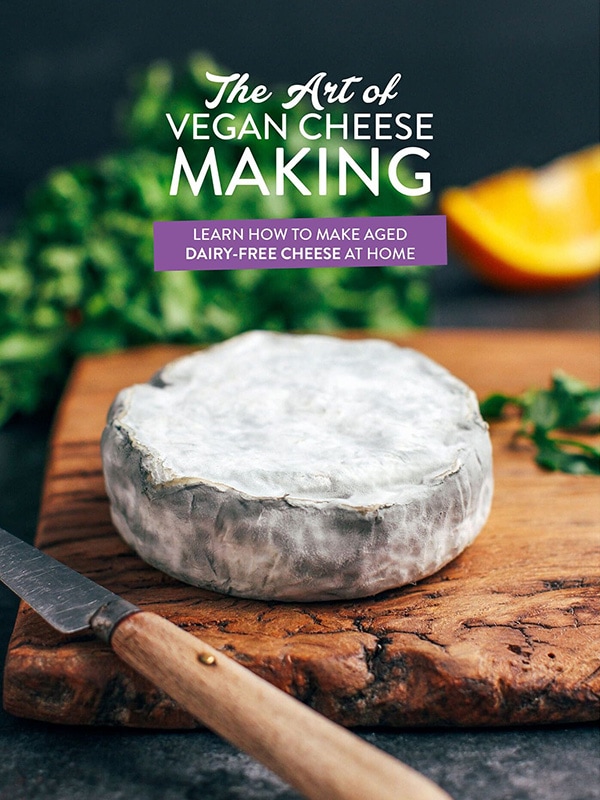
🧀 25 Mind-Blowing Vegan Cheese Recipes!
Sign up for the Full of Plants newsletter and you’ll get new recipes delivered by email weekly, PLUS your FREE 100-page printable eBook!






My cheese is two weeks old and has quite a lot of white mould, but also some black spots appearing. I think this is bad, based on my experiences with making Camembert with dairy milk in the past. I think the problem could be temperature or humidity. The room temperature here is about 20degreesC. Do you have an idea why this is occurring and whether it is a problem?
Hey Beryl,
I think the temperature is the problem here, it should not be above 14-15 degrees Celcius. If you don’t have a room with that kind of temperature I can only recommend aging the cheese in your refrigerator, it will work like a charm and there is very little chance you will get black mold.
What you can do is carefully remove the black spots with a clean knife and add a pinch of salt in the holes. If you only have a few black spots, it should work and “save” your cheese!
Thomas, I ended up eating those cheeses at about 2.5 weeks(delicious!) and now I have a new batch kept in a cooler place. They are at 2.5 weeks now and there is no sign of black mould! I am so excited. The white mould is looking very good, and whole family is drooling in anticipation!
Thanks so much for this recipe. I now wait with ‘bated breath for your blue recipe….and dare I hope for a washed rind after that?
That’s great news!!
I know that feeling when you see some white mold starting to grow on the cheese 🙂
About the blue cheese, it is definitely coming soon. Washed rind?! That’s a challenge!
At least you will be able to compare the cashew cheese with and without the white mold, you will see, the taste is really different!
Hi Thomas
The recipe said about 1/8 tsp of the powder, but i think i may have measured wrong. What happens if you use a little less of the PC than the recipe says?
Hi Lauren,
Nothing is going to happen, even 1/16 tsp is enough as the mold is very powerful. I recommend 1/8 tsp as it’s the easiest to measure 😉
Thomas I made this cheese and it is SO delicious. You are a genius thank you.
Have you tried using Penciillium Roqueforti to make Bleu cheese?
Or a combination of penicillium candida and roqueforte …would that make cambazola?
Thank you so much!
Peggy
I’m so glad to hear it worked well for you! 🙂
I do have penicillium roqueforti and I’m currently experimenting with it, my first two batches were not successful though. The process is a little bit different, but I will be sure to post the recipe when I have something that tastes like blue cheese!
As for mixing both, I’m not sure about the result, you might have to try it 😉
Tried it. It works – and seriously it does taste as good as or even better than Camembert made with cow juice. Thank you so much.
Awesome! Thanks for the feedback! 😉
Hi Thomas, I would like to know if I can use your recipe of camembert using goat cheese starter culture instead of penicilium candidum my starter has penicillium too.
Thank you so much
María
Hi Julia, you won’t get the same results and definitely not the white rind using a goat cheese starter. There are many molds in goat cheese starters, the taste will be different. I think it can result in a pretty tasty cheese though 🙂 but it will not look like a camembert.
Hi Thomas-
My cashew cream is very soft, and even after being in the refrigerator for a day, slowly falls apart after being taken out of the mold. Is there a way to fix this and save the bath? I probably added too much water because I do not have a a very good blender.
Hi Julie,
I would try waiting for another 2-3 days as usually the cashew cream will firm up a bit after the salting step (which helps remove some of the moisture).
Otherwise, you might have to make another batch.
Thomas-
Thank you! That worked!
I just posted another question about the mold coloration. My cheese is getting covered with an orange-ish pink color (not furry mold) Is this a precursor to the white mold? I have been scraping it because I thought it was the dreaded “pink mold”, but I’m not sure. I have several patches of very furry white mold that seems to grow alongside the discoloration.
Thank you again so much for your incredible recipes and dedication!
-Julie
Hi! I’m on my second attempt at this 2 weeks in and it’s firmed up but not got a white mould on what am I doing wrong?! Got it in the fridge but it’s a kind of my spare broken fridge that is a bit on the warm side so technically the perfect temperature that you have on the recipe! I used a powder penicillin so did what you said on the notes (but it in sterilised cold water and in the fridge before using it to blend the cashews)
Hi Annie!
I’m sorry to hear it’s not working as expected for you.
Did you salt the cheese? Salt is really important in the development of the white mold, it encourage mold growth.
Also, where do you store the penicillium? Most of the brands recommend you keep them in the freezer.
If the temperature is right I don’t see why the mold is not appearing…The environment should not be too dry though, the mold needs some moisture to develop.
We are talking about penicillium right? Not penicillin.
Feel free to keep me updated so we can figure out where is the problem.
Thanks for the reply!Yeah I salted them and it’s definitely not too dry, not sure what I’m doing wrong! And yes I ordered the penicillium you suggested that was just autocorrect! In the first stage you suggest covering it to keep humidity in, is this just for the first day or for the whole process? I’ll have to try again I guess!
If you have a cheese box, or a plastic container I recommend you cover the cheeses with it (for the whole process). Don’t seal it, leave some space so the air can pass through.
I would not throw the cheese away, I would re-salt them a little bit wait for another week to see if the mold is taking longer to appear. If it doesn’t, you can still eat the cheese, it won’t have the same flavor but they should be tasty!
Make sure your penicillium is not expired, the only time I got this problem, the one I was using was expired.
Thank you! It is in date but I might order some more just in case!
Any substitute for penicillium candidum ? I’m allergic. Thanks.
Hi Caroline,
I’m afraid there are no substitute, without penicillium candidum you won’t get the “camembert” flavor or the white flowery rind.
Ok, thanks for your fast reply.
Hi Thomas!
I have given a shout out on my facebook group Plantified https://www.facebook.com/groups/Plantified/permalink/1162967703761393/ about your magnificent discovery with your camenbert cheese!
People are very interested in what you are doing!
Also @Anderson Santos, I mentioned what you have been up to also!
If you would like to come and talk to people about what your are doing, feel free to drop in and chat!
Hey Katrina,
Thanks for the shout out! 🙂 I checked your facebook group, very interesting!
So, apparently many people are worried about the mold being vegan or not. The one I bought was labelled as “vegan” on the website, and the brand was Danisco. There is no vegan logo or other information on the package itself, so I guess all the penicillium from this brand is naturally vegan. That’s why I link to a penicillium from this brand.
Yes!
Anderson Santos also was told brands were vegan, but when i spoke to a fellow called Bruce from gnltd.com , and asked him if he could stock some vegan stuff he said : Hi Katrina – thanks for all the information; it is most fascinating.
If you dig deep, the culture that Thomas is actually using for his cashew nut ‘Camembert’ originates from Danisco: the Danisco rep. told me recently that his company “doesn’t do vegan….”
I have never got a straight answer out of Danisco and they have never once come back to me when I repeated asked them this direct question: “Do you sell a culture that is not only suitable for, but also classified as vegan?” – so I will leave it to you to make up your own mind as to the legitimacy of these articles!
Similarly the https://shop.strato.de/epages/62318676.sf/secba30164717/?ObjectPath=/Shops/62318676/Products/005HEC link leads to an Amazon site that sells Pen Candidum in plain pots. I would be very surprised if this was not simply a standard Danisco (or other) non-Vegan culture that has been simply decanted…. I would certainly expect a Vegan certified logo next to it if it was suitable.
Sigma (part of Sigma Aldrich Inc.) is an American chemical company that has a reasonable bio-chemistry division: I used to regularly deal with them many years ago when I was part of a team of research chemists looking into natural and nature-identical flavourings. I’ll look into their products and if I have any luck finding a vegan starter culture that I would be happy to promote and sell, then I promise you that you will be the first to know!
Kind regards
Bruce
I also showed him a link to what you were doing with it after he sounded doubtful any vegan cheese could be decent and he was impressed!
I am concerned that Danisco are giving mixed messages about whether it is free from animal product use or not, so will be interesting to see their response!
I feel that some companies won’t attest to it being vegan if not certified, even if it may actually be plant grown.
My research has shown it is often cultured on canteloupes and lemons, but maybe these cheese supply companies aren’t usually that concerned as their customers are usually Dairy eaters anyway?
Thanks for the nice feedback 😉
I think you are right about companies not being really concerned wether it is vegan or not since 99.9% of their buyers are non-vegan companies. That’s probably why their answers are never completely clear, they don’t really care.
As you can see here, this website is also selling a “vegan” penicillium candidum (from Danisco): http://www.oberacker.de/product_info.php?products_id=2743&osCsid=vbh9in569dvufg7b1dlh81urv0
At least I know for sure that penicillium candidum can be vegan since I heard about vegan-certified companies producing very similar camemberts with only cashew, cultures and mold.
I didn’t know about the mold growing on cantaloupes though, interesting.
Yeah, here is the article I found that out in!
All commercial penicillin comes from cells extracted from a mold growing on a cantaloupe found in Peoria, Illinois, in 1941.To make commercial penicillin, you need a descendant of this strain.
https://sites.google.com/site/lowmoonglowing/penicillin
Also they had another really interesting article on different moulds and what is and isn’t safe!
Makes good reading!
Apparently pink mould is dangerous, so if you see pink mould on stuff in the fridge, stay well clear!
https://sites.google.com/site/windintheroses/mold
Hey thank you for sharing such a revolutionary recipe in a open-source way 🙂
Before I try it I am wondering if ‘rejuvelac’ would work instead of water + probiotics?
http://www.marystestkitchen.com/make-rejuvelac-culturing-cheese/
All the best,
Jan
Thanks Jan 🙂 Yes rejuvelac will work as well, I just find it easier to use probiotic than making rejuvelac from scratch.
How about using some soy yogurt (or whey from it)?
I never tried with yogurt but it contains different cultures, so I’m not sure what would be the result honestly.
Yours is hands down the best vegan blog I have ever come across. Your recipes are stellar! You do the vegan community a great service. When I was vegan, I missed dairy cheese so much that I fell off the vegan wagon. Your recipe makes me feel like crying for joy. Where is your James Beard award???! One other question- will this work with other nuts, like macadamia? I don’t eat cashews as they’re high in FODMAPs.
Thank you so much!! 🙂
I agree with you that cheese might be the food you “miss” the most when going vegan.
It’s really worth waiting a few weeks to get a cheese that taste like a real blue cheese and not like those fake flavored vegan cheeses.
I never tried with other nuts, but I think it would work with raw macadamia nuts. Since macadamia nuts are higher in fat than cashews I would remove the coconut oil from the recipe.
Hi Thomas, I am just at this very moment starting my first camembert with your recipe. It’s time for fermentation at the moment press your thumbs so it will work.
I’m using powdered penicillium. Should I really soak it in 1 cup of filtered water, when I’m just going to use 8 tbsp of it?
I’m curious to see your reply, Thomas. I use powdered Penicillium too, and the first time used 1 cup of water, cheese molded over fine, but was initially very wet, and hard to handle. The second time I tried it I dissolved the Penicillium in 10 Tablespoons water. This time the cheese batter was more solid, but it never formed the proper mold. I have now my third batch just settled into its pans to begin the aging process. This time I used 8 Tablespoons – I now have my fingers crossed the mold will form.
Nancy, I’m afraid my instructions were not clear enough. When I’m saying “Use this water in place of the filtered water”, I mean the same amount: 8 tablespoons.
I’m recommending to use 1 cup of water because it’s easier to bring to a boil than just 8 tablespoons.
I’m sorry for the misunderstanding, I will try to make this clearer in the recipe.
I hope your cheeses will turn out great this time!
Hi again Thomas!
My last 2 attempts have resulted in cheeses that grow mold only on about 1/4 of the surface of the cheese (if not less). What would be your guess about why the mold is not growing uniformly and covering the cheese? I am using the ingredients as specified in the recipe, and keeping the cheeses under a plastic tub in a fridge kept at about 57 degrees F, turning daily. I am wondering if the problem is either expired mold, or not using enough mold in the mix (I use 1/8 teaspoon as directed). I also get a very slightly pinkish/orange mold growing near the white mold in some places, and since I understand pink mold is dangerous to eat, I’ve thrown away one batch so far. Hate to do that if it can be avoided. Do you have any suggestions?
You can just bring some water to a boil, let cool completely and dissolve the powdered penicillium in 8-10 tablespoons of water.
Hello Thomas!!!
thanks to share with us this recipe… i already bought the penicillium and the capsules and i want to start tomorrow, but i´m stuck how this works…. Should i disolve in 8 tablespoon of water but how many grams? just a little tiny pinch? buecause inside the envelope is not many…. Please help this poor beginner.
p.s: sorry if you already explain how to do it, i just can´t find it!!
Thanks Thomas
Hi Fanny,
You’re welcome!
So, if your penicillium is in powdered form: bring a cup of water to a boil and let it cool completely (or just use filtered or bottle water).
In a small and clean glass: add about 10 tablespoons of this water and 1/8 teaspoon powdered penicillium, about 3 pinches. Give it a quick stir and cover with a plastic film and place in the fridge, let sit overnight. This step is required to rehydrate the penicillium candidum.
The next day you will blend the cashews, probiotics powder and about 10 tablespoons (8 if you have a powerful blender) of this water together.
I hope this helps!
Thanks Thomas!!!!
very helpful info, i will start tomorrow, so exited!!
Thomas this step is missing in both sets of directions. I’ve been working on my cheese for nearly four weeks now and only a little bit of mold has grown. I’m assuming this is the reason why. Is there anything I can do now? Should I wait longer? Is it ok to just eat the cheese? It’s frustrating to have spent all this time and effort only to find this out now. I used the link in your page to get the penicillium in dry form as I’m sure others did, but there’s no mention of this step in the notes. Can you please update the notes explaining that you need to soak the bacteria overnight so other people don’t make the same mistake.
Andrew, if this step is “missing” from the directions it’s because I found out it’s not essential at all. I have made countless batches of camembert and always added the powder directly to the blender. I don’t bother soaking it anymore and it works like a charm.
If you only have a little bit of mold growing it’s definitely not because you added the powder directly. The most common problem is that the exterior of your cheeses dried too quickly. If it’s not moist enough the mold cannot grow on the exterior. I guess it’s dry to touch? Did you keep the cheeses covered the whole time? At what temperature are you aging them?
I would appreciate if you could update your rating next time you make the cheese, thanks! Good luck 🙂
Wait, we’re supposed to dissolve powdered penicillin in water before using it?! In the video I thought it went straight into the blender with the cashew cream and the water, I didn’t dissolve anything… the recipe also doesn’t mention it… should I throw it away, will it not work?!
Amanda, I used to dissolve it before. Now I don’t do it anymore and just add the dry cultures to the cashew mixture, it works just as well (and I made countless batches).
Do you think that som coconut oil would add better and creamier texture to the Camembert cheese, like you do in the blue cheese recipe?
I added coconut oil to the blue cheese recipe because the blue mold needs more fat to grow than the penicillium candidum. You can add coconut oil to this recipe too, it will make the camembert cheese a little bit creamier and will help firm it up in the early days of aging. I find it pretty creamy without any additional oil though. Hope this helps! 🙂
Thank you! I will make one of the molds with some coconut oil to see what the diffrence will be.
My parchment paper were really sticky so I used plastic film instead, which doesn’t seem to stick much at all. Do you see a problem with using plastic film instead?
No problem at all with plastic film!
Hello Thomas!
It has been great for me to discover your blog, it´s really interesting… congratulations!
I´m experimenting with cashews-based cheeses, I´m from Argentina and here the summer is TOO HOT,over 40ºCelsius, so I decided to buy a small wine cave (for only 34 bottles of cheeses….NO! I mean wine) …well, the fact is that I planned to use this equipment to age my cheeses. The thing is that the Humidity levels are really high (84%)… temperature is OK at 12ºC.
Because I want to do all the process of aging from start using the cave (to avoid exterior temperatures), I started by introducing the “fresh” cheeses, into the cave… but after 4 days they are still in a creamy-like form…. should it be humidity, or should I install some coolfans, in order to air-dry my cheeses? I thought about installing some Computer-fans into the cave.
Well, I would really appreciate if you shed a bit of light into this….
Thanks in advance
Hi Claudio,
Thanks, glad you like it!
I’m no expert in humidity levels 🙂 but I think 84% is okay to age the camembert cheese. I know some people here had great results by aging the cheese in their fridge, so the humidity was pretty high.
Be careful, you don’t want to dry the cheese too quickly, the mold needs humidity to grow.
About the consistency of your cheese, I would advise to be patient and wait another 4-5 days. I had some cheeses that took more time to firm up. Also, you might want to try using a little bit less water next time, the cheeses will firm up faster.
Hello, I am really looking for a recipe like this but the Penicillium Candidum is NOT vegan : it is lactose based. I have done a lot of research on this and have written to many suppliers. Do you have an idea for me because I am 100% vegan and do not want to make exceptions. This recipe looks so delicious but I would be unhappy using the Penicillium Candidum.
Thanks for your comment.
Hi Deb,
I’m not sure which brand you are talking about, but I also did some research and found some that are labelled as vegan (the Danisco one for example). There are also some vegan cheese makers in Europe who are using penicillium candidum to make vegan camembert the same way as explained in this recipe. These cheese makers got the certified Vegan logo, so I can say for sure that penicilium candidum (at least some brands) is vegan.
Thanks for your reply but unfortunately Danisco is not vegan as it is grown on a milk product. I will send you their information leaflet which shows that. I am desperate to try your recipe but just can’t find a truly vegan penicillium candidum.
I do have a documentation too that shows lactose is not in the allergens. Also, this means not ALL penicillium are grown on lactose (some are grown on maltodextrine as Anderson said).
So sorry, Thomas, you are absolutely right. I just had not found the right product. Thanks for the link. I have bought some and will be making my cheese as soon as it arrives.
No problem Deb 😉 Don’t hesitate to comment if you have any question about the process.
Hey Thomas, I tried this recipe. The mould grew as expected, but the cheese had a somewhat lemon flavour, not like camambert or brie at all, and it was pretty solid, not runny like camambert. Any suggestions? Adding some coconut milk or other non-dairty milk? Thanks!
Hey Andrew,
I’m not sure what happened, but you shouldn’t get a lemon flavor. The inside is not as runny as a camembert though, but still very soft, and even softer when at room temperature for a few minutes.
Did you use acidophilus powder? I find acidophilus gives a much better taste than rejuvelac. Depending on the type of rejuvelac used, it can sometimes give the cheese that lemon flavor, that’s why I recommend powdered probiotics.
About the texture, you can add 2-3 tablespoons of refined coconut oil when blending the cashews, this should give the cheese a creamier texture.
Thanks Thomas. I did use acidophilus powder. Maybe I didn’t wait long enough, I think I ate it before two weeks.
you are a genius!!! the only reason i couldnt go fully on a plant based diet was because of cheese! i’ll try this right away! thank you, thank you, thank you!
on what grounds do you base this statement? not all penicillium candidum cultures are grown on lactose.
I would like to know the answer to this question as well, since I am unable to find any vegan source for the penicillium. It is for certain that the one recommended is grown on and therefore does contain lactose. Wish it were not so!
This is a question that I often receive. Unfortunately, I can’t give you a link to a vegan one at this time, if you are not located in Europe. It seems it’s harder to find a vegan penicillium candidum in the US. I would recommend checking the Danisco ones and then check out the documentation to see if lactose is listed as an allergen. They have some vegan ones for sure.
When a vegan penicillium is available on Amazon I make sure to change the link, but it’s not very often and it goes out of stock pretty quickly.
Hi,
I’m ageing my cheese in the fridge and it has been there for 7 days now. The first small patch of mold have now appeared on day seven, which seems about right, right? It had a lovely dairy like smell until 1-2 days ago, but now it is starting to smell different. Not unpleasant, not yet anyway, but not like that fresh dairy smell it used to have. I don’t know how to describe the smell, not very sharp, not earthy or moldy and not dairy.
I changed to a bamboo matt 2 days ago, that i didn’t sterilize. I don’t know if that makes a difference.
How have your cheeses smelled through out the ageing process?
Honestly I’m not sure about the smell, it’s not something I payed attention to. As long as the white mold is growing you are on the right track! (it should cover the entire cheese soon)
About the bamboo mat, if it is clean I don’t think it will be a problem, just make sure to flip the cheese everyday and you should be good. Keep me updated!
This is wonderful! It took a lot longer as I made it in the fridge. The mold took awhile to cover the cheese. The flavor is similar, due to the Penicillium, but not quite as creamy (less/different fats, perhaps). It was fun to make and worth the wait.
Hey Thomas, I’m making both – camembert and the blue cheese – at the same time, aging them in one refrigerator. And therefore I keep them all locked in boxes. It is day 7 now (if we’re counting from the day we blend the cashews, correct?) and no mold appeared yet, on either. They are still very soft, which makes it really tricky to flip the cheeses. Could this be caused by the fact I keep them in boxes instead of just on the bamboo mat with access to the air flow? I know that the blue cheese needs more humidity but is it good for camembert to stay in the box as well? Temperature in the fridge is 10C, I hope the mold will sppear soon. I used powdered cultures but I wonder if it makes any sense to dissolve some more mold cultures in water and spray the surface of my cheeses… What do you think? I don’t want to make them more moist, because like I said – they are still pretty soft, but I’m afraid I might have added not enough powdered cultures at the beginning. Many thanks in advance for your tips and suggestions. Cheers!
Hey Pedro,
That’s awesome!
Yes, 7 days after blending you should see some mold growing. It can take more time though, especially if you age them in your refrigerator, since it slows down mold growth. I had some cheeses where mold grew in 3-4 days and others where it took over a week.
I recommend you wait another 3-4 days and see if the mold appears, don’t spray the surface yet. You should move the cheeses to a bamboo mat only when they are firmer, otherwise they will stick to the mat.
Penicillium candidum/roqueforti is really powerful, I really doubt you didn’t add enough. Just a pinch usually work.
By the way, be careful when aging two different cheeses in the same place, sometimes molds can transfer very easily. It happened to me, I aged basic cashew cheeses (with no added penicillium) in the same place I used to age my camemberts, and they developed a white rind!
I hope this helps, and please keep me updated!
Hi Thomas,
thank you for your response. It is day 13 now and still no mold has appeared on my Camemberts 🙁 I know you said it might take longer to develop in the fridge but the temperature is not much lower than the recommended 11-13C. In addition all of my cheeses are still relatively soft. I could move them to my cellar but can’t really control the temperature there, it changes during the day and might even exceed 13C. I did spray the surface with additional cultures eventually, few days ago. Not sure what to do next…
Is it really ok to keep the cheese locked in the box? I get the impression that the smell has changed, not the pleasant way – it reminds me of some organic waste kept in the bin for few warm days, kind of rotten stench, not too strong but definitely it doesn’t smell invitingly…
Whereas my blue cheese “medallions” (still soft as well and not smelling nice either) turned brownish here and there. I have also noticed some small tiny hairy mold spot, like microscopic sprouts with black heads. Now – how do I distinguish the proper, desired mold from the one we should avoid? I did sprinkle salt all over the cheese and rubbed it into its surfaces.
All of this doesn’t seem right but what could have gone wrong?
Cheers!
Pedro
Hi Pedro,
Unfortunately if you cheeses don’t smell “good” it’s not a good sign and I would recommend not eating them. The camembert should have lemon-y smell, and once the mold has developed it should smell like mushrooms. I will be honest, I have no idea what happened here, I age my camemberts covered with a plastic box in a cellar (with temperature variations), but I know many people here aged the cheese in their fridge with no problem. I will actually try to age them in a fridge next time. Since you don’t have a lot to lose now, I would try to move the camemberts to the cellar, and cover them with a plastic box. By the way, was the water completely cool when you mixed in your powdered penicillium candidum?
Now about the blue cheeses, I’m not sure about the smell. If you have dark/blue spots appearing you are on the right track. The mold appears slowly, spot by spot. I don’t have photos of the mold growing, but check this link: http://www.onetomato-twotomato.com/2015/05/making-blue-cheese-at-home/
As you can see, some spots are dark, blue and white, it’s not looking as nice as the white rind on the camembert (it’s looking pretty bad actually :)). Keep on flipping your blue cheeses, the mold will grow uniformly after a few weeks.
Hey Pedro,
I think I found what might be your problem. I recently made another batch of cultured cashew cream to make my fried cheese balls. The thing is, this time I let the cashew cream sit overnight on a radiator. The next morning the cashew cream was smelling like rotten eggs. I made another one and this time I let it sit on the counter, no problem at all, the cashew cream was smelling good (like fresh cheese). I think the cashew cream goes bad if you let it ferment at a too high temperature.
I can second that. Had mine in spare room that gets a lot of sun. No mould and the cheese smelled awful
Wonderful recipe! I appreciate all the hard work you’ve put into this and for spreading the love to the world.
I hope that you also experiment with some other nuts. Unfortunately, I have to avoid cashews (as much as I love them) because I am unable to digest them. I would love to see recipes like this that use almonds, macadamias, or even hemp hearts.
Thanks for the kind words Gyan!
I’m sorry to hear you can’t consume cashews, I do plan to try the recipe with other nuts.
I just managed to wait as long as I had to to finish my first five camenbert with this recipe. They went out really great. I love the taste and the structure. We soon will have finished them, need to start new ones…
Hey Eva,
I’m so glad to hear you successfully made the camemberts! 🙂
Thank you so much for your feedback!
I am really looking forward to these! Vegan cheese is one disappointment after the next, with unskilled people all claiming the next big thing, but somehow they all taste vaguely like sugar and sadness. It’s a damn shame all the interesting ones exclude those with nut allergies, but this one is so wonderful looking, I did it anyway. Just have to keep my husband away. so he doesn’t die. I’ve got it all timed to serve at my all vegan (Canadian) Thanksgiving in a few weeks. Thanks so much!
I’m in the middle now and I’ve been quite frustrated with the instructions almost every step of the way. The temperature of the room? I know it’s Fahrenheit, but it would have been nice if you’d included that, as I think in Metric (as does most of the world) and wow! That’s one hot room. Some of the key instructions are not included in the recipe – such as how long to keep the cheeses in the spring form pans and even exactly how you put the parchment in the pans. I can’t scroll up and down without losing my place, though I am very cautious with new techniques, especially ones as expensive as this venture. I definitely took my cheeses out of the spring form pans immediately after shaping them, simply because I grew irriatted with searching up and down the pictures to try to find what should have been in the recipe itself.
Hi Renee,
I’m sorry to hear you were frustrated with the instructions. You are the first one to tell me about it, and I agree that some steps might be a little bit confusing.
I made a few adjustments concerning the temperature (obviously it’s in fahrenheit, we are not baking cheese here 🙂 ), and how long you keep the cheeses in the pans.
English is not my first language, so feel free to let me know if some steps are not completely clear to you and I will re-write the instructions.
I really hope your cheeses will be ready for your vegan Thanksgiving! Do not hesitate to ask if you have any additional questions.
Hey Thomas, thanks a lot! I didn’t mean to sound so prickly about it; I am so genuinely excited and impressed with your recipe. I will definitely let you know how it turns out – I’ll tag you on Instagram when they’re ready and let you know how my guests feel about them. Can’t wait to try the blue cheese, too!
No problem at all!
I can’t wait to see your cheeses!
Hi again. Just to say I am on day 2 of flipping my cheeses over. I have a small unused fridge that I put on the lowest setting to keep my cheeses in as it is still hot in my house. I did not cover the cheeses after flipping today…should I have? Thanks again for the recipe and for helping me find truly vegan penicillium!!! Kind regards from Deb
Awesome! If you just missed a day it doesn’t really matter and won’t affect the mold development.
I just managed to finish the work on my first five camenbert. They are jus fabulous. After four days in the fridge, they just taste exactly like camenbert from cowmilk. Will have to repeat it soon. Love it!!!